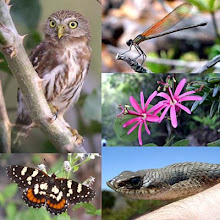August 24,
2015
This morning
Fabrice and I switched destinations, which meant I took my half of the group up
to Tower I – the 53-meter canopy tower that is located just 800 meters down a
trail from the common area. The fruiting Zanthoxylum
tree next to the tower has just a few fruits left after being so generous
the past three weeks or so, but we still had Red-billed Pied Tanagers a few
feet away, a pair of very cooperative Yellow-shouldered Grosbeaks, and a
stellar performance from the pair of White-browed Purpletufts from two weeks
ago.
A Purple
Honeycreeper also posed nicely for photos.
Another Zanthoxylum a few trees away was of
interest to these White-eyed Parakeets.
On our
forest walk afterwards we saw a few birds, such as Red-headed Manakin on the
lek and a Black-tailed Trogon. But we were quite lucky to see this Anolis punctatus, Amazonian Green Anole
on a tree at eye level.
And as it
got warm, butterflies became active. This hairstreak is the very widespread but
attractive Arawacus separata.
As it was perched
on the underside of a leaf, this Nymphidium
mantus, Mantus Metalmark, took some patience to photograph. In flight it
was a little black and white twinkle, so we were all wowed by the photographic
result.
Another
under-leaf percher is this Nymphidium
leucosia, Leucosia Metalmark.
And even tricker to photograph (because it's very shy and perches under a leaves very close to the round) was this Mesene leucophrys,
Leucophrys Metalmark.
This is Colobura annulata, New Beauty – only by
comparing photographs can I ever tell it apart from the Dirce Beauty.
Our final
butterfly of the walk was this rarely seen metalmark Pandemos pasiphae, a female.
We just
barely got back to our rooms to wash up and organize before lunch when Fabrice
came rushing by screaming like a mad man. “Harpy Eagle, get down to the boats
now!” I opened my door to see him running off to alert everyone in the more
distant cabins. I made sure the participants who were with me had heard him,
rushed down to the dock, and saw that people were loading up on boats. Where?
How far? When? What? Wait – not everyone was here, but the boat was full. Go,
go, go! I’ll go find the others, and a second boat will follow. I ran to the
common area, ran to all the rooms, and finally found the missing participants
who finally came out of their cabin, all dressed for an outing, not understanding
that “now” meant “don’t get dressed.” We got back down to the dock to a boat
waiting with a few other agonizing people from other groups staying at lodge..
Long story short: the Harpy Eagle originally had been spotted by local guide
Sebastião just over a kilometer downriver taking a drink from the beach, had
moved to an open perched by the time the first group arrived, and was enjoyed
enthusiastically by the first boat. But it then flew off into the forest away
from the river some 30 seconds before our boat arrived. I felt bad for everyone
in our boat. Me, I’ve seen six Harpy Eagles, one sighting at Los Amigos in Peru
that could never be topped, so I personally wasn’t the least bit disappointed
for myself. Some amazing photographs were obtained by people in my group,
including this one by Fabrice.
As it seems
it’s never been published, and to prove that I missed nothing on this trip, here’s
my photo the Harpy Eagle that flew over Sam Woods, Daniel Huaman, and me on the
Los Amigos River almost exactly three years ago. Nearly all photos of Harpy in
flight light this are staged, captive or released birds. Not this one.
We then planned
to do some more trail birding for the afternoon, but we were sidelined by the
report of a troop of White-nosed Sakis (Chiropotes
albinasus) by the common area. We followed them for several minutes down to
the walkway to the floating deck where some people got some great photos.
Then as we prepared
to set out for our hike, one of the participants yelled out “snake!” Of course
I came running and found a nearly legless lizard instead. Sort of a better
find, as a squiggly snake might get away unidentified from my unwillingness to
pick up potentially venomous species. And I had certainly had never seen this
critter. This turned out to be Bachia
flavescens, a “microteid” lizard in the family Gymnophthalmidae. What an
amazingly cool animal.
Finally,
about 45 minutes late, we set out for our longish (2 ½ km) walk down the Taboca
trail loop, I with five participants going one direction, Fabrice with four
going the other. My group got very lucky by finding a busy mixed flock that had
a number of goodies such as Yellow-backed Tanager, Long-billed Gnatwren, and
Chestnut-crowned Becard. But maybe the prize from our walk was seeing the Red-bellied
Titis (Callicebus moloch) in a patch
of bamboo. I even managed a poor photo.
We also
stopped to take photographs of curious rainforest things. This is the fungus Camillea lepreuriii, looking like
cigarette butts.
This is the
juvenile form of a Philodendron.
Should the roots be so lucky to reach fertile ground and the upper stem a good
patch of light, the next generation of leaves will be the large floppy things
most of us associate with a house plant.
Finally just
one photo from the moth sheet: Automeris
egeus, a saturniid silk moth.

























No comments:
Post a Comment